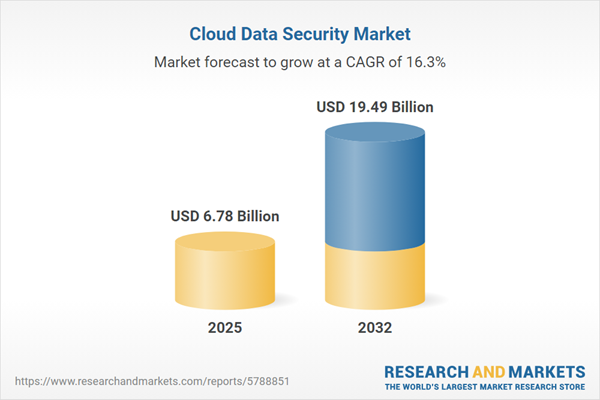Speak directly to the analyst to clarify any post sales queries you may have.
Cloud data security is a critical focus for organizations seeking to protect sensitive assets, ensure compliance, and maintain trust as cloud adoption accelerates. Senior decision-makers face ongoing challenges in building robust frameworks suitable for today’s complex digital environments.
Market Snapshot: Cloud Data Security Market Growth
The global cloud data security market is expanding rapidly, with growth driven by intensified digital transformation, increased regulatory oversight, and rising adoption of integrated security models. Corporate strategies are shifting away from legacy approaches as organizations unify governance across distributed architectures. This evolution enables more agile responses to emerging threats and supports resilience throughout the transition to advanced cloud ecosystems.
Scope & Segmentation of the Cloud Data Security Market
- Component Types: Core solutions consist of cloud access security brokers, encryption platforms, and data loss prevention tools. Key supporting technologies include identity management, multifactor authentication, data masking, and centralized key management, providing comprehensive oversight for cloud-native and hybrid deployments.
- Deployment Models: Hybrid, public, and private cloud options give organizations flexible paths to deploy security frameworks. Choosing the appropriate model ensures alignment with both operational strategies and compliance requirements during digital initiatives.
- Service Models: Security solutions cover IaaS, PaaS, and SaaS environments, supporting organizations’ demands for adaptability as they introduce new services and tackle emerging threat vectors across the IT landscape.
- Organization Sizes: Solutions address the full spectrum, serving both large enterprises and small to medium-sized businesses. Emphasis is placed on scalability and seamless integration to support long-term growth and digital transformation.
- Industry Verticals: Key sectors include finance, insurance, energy, government, healthcare, IT, telecommunications, and retail. Each vertical responds to unique regulatory landscapes and threat profiles, underlining the need for industry-tailored protection and compliance strategies.
- Regional Coverage: Providers adapt offerings to suit regional regulations, privacy rules, and data sovereignty needs, enabling organizations in the Americas, EMEA, and Asia-Pacific to navigate distinctive compliance and risk-management challenges.
- Leading Companies: Top global vendors such as Microsoft, Amazon Web Services, Google, IBM, Oracle, Palo Alto Networks, Check Point Software Technologies, Broadcom, McAfee, and Trend Micro deliver solutions that meet diverse cybersecurity needs and address the requirements of enterprises worldwide.
Key Takeaways for Senior Decision-Makers
- Encryption and tokenization are essential for establishing sound data governance, supporting stakeholder confidence, and ensuring consistent security across multiple cloud environments.
- Centralized governance frameworks enhance organizational agility, allowing swift adaptation to evolving compliance demands with minimal business disruption.
- Automating security workflows and unifying procedures enable faster expansion and responsive risk management, equipping organizations to counter unfamiliar digital threats with efficiency.
- Industry-specific compliance expertise remains vital for successfully navigating rapidly changing regulatory environments and minimizing exposure to liability.
- Interoperable vendor solutions and integrated analytics allow businesses to proactively refine risk strategies and align protection efforts with overarching business goals.
Impact of 2025 United States Tariffs
- Recent U.S. tariffs affecting hardware security modules and encryption appliances are prompting a shift toward software-based and cloud-native security architectures, reducing reliance on specialized equipment.
- There is increasing adoption of subscription-based licensing and managed security services, valued for adaptability and cost-efficiency amid global supply chain constraints.
- Procurement priorities center on transparency and rapid solution evaluation, helping ensure operational continuity as market dynamics evolve.
Methodology & Data Sources
This analysis synthesizes findings from executive-level interviews, large-scale market surveys, patent and regulatory reviews, and trusted industry journals. These diverse sources enhance the accuracy and breadth of the information, supporting informed strategic decisions in cloud data security.
Why This Report Matters for Cloud Data Security Strategy
- Decision-makers can coordinate security investments with dynamic compliance mandates, directly contributing to strengthened IT operations and risk alignment.
- The report provides actionable insights for assessing new technologies and solutions, supporting tailored approaches to sector-specific compliance and risk.
- Guidance supports agile optimization of internal security resources as digital transformation and regulations continue to evolve rapidly.
Conclusion
This report delivers strategic, executive-focused insights to enhance cloud data security, simplify regulatory compliance, and support secure, sustainable organizational growth as cloud environments continue to evolve.
Additional Product Information:
- Purchase of this report includes 1 year online access with quarterly updates.
- This report can be updated on request. Please contact our Customer Experience team using the Ask a Question widget on our website.
Table of Contents
3. Executive Summary
4. Market Overview
7. Cumulative Impact of Artificial Intelligence 2025
Companies Mentioned
The companies profiled in this Cloud Data Security market report include:- Microsoft Corporation
- Amazon Web Services, Inc.
- Google LLC
- IBM Corporation
- Oracle Corporation
- Palo Alto Networks, Inc.
- Check Point Software Technologies Ltd.
- Broadcom Inc.
- McAfee LLC
- Trend Micro Inc.
Table Information
| Report Attribute | Details |
|---|---|
| No. of Pages | 193 |
| Published | October 2025 |
| Forecast Period | 2025 - 2032 |
| Estimated Market Value ( USD | $ 6.78 Billion |
| Forecasted Market Value ( USD | $ 19.49 Billion |
| Compound Annual Growth Rate | 16.2% |
| Regions Covered | Global |
| No. of Companies Mentioned | 11 |









